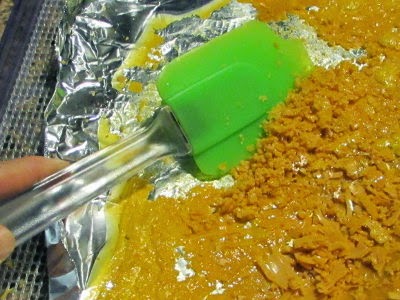Winter is very unpredictable when it comes to eggs. Most winters I get an egg or two per day, but sometimes I get none. Chickens don't lay when they're molting, of course, and lay less when daylight hours get short. Our winter diet adjusts to having less eggs, but also I preserve as many as possible for when laying times are lean. I do this by freezing, dehydrating, and water glassing.
Freezing eggs is fast and easy. Simply beat them as for scrambled eggs, pour into ice cube trays or muffin cups and pop in the freezer. After they're frozen I put them in freezer bags to save on space. Frozen eggs are great for baking, scrambled eggs, or omelets; I just have to remember to allow time to defrost.
 |
I use ice cubed eggs as small singles.
A muffin cup will hold close to two eggs. |
I've only frozen about six dozen eggs so far. That's not a lot, but honestly, we eat one egg meal per day when laying is good and I'm a little tired of eggs! (scrambled, fried, egg salad, hard-boiled, deviled eggs, quiche, French toast, you name it.)
Dehydrating is the most intensive in terms of energy and labor, but powdered eggs are easiest to use, plus they take up the least amount of storage space (cool storage is recommended to prolong shelf life). They can be reconstituted with an equal amount of warm water or milk to make scrambled eggs or quiche. Or they can be added as powder to doughs and batters.
Dehydrating eggs is next on my to-do list. The basic process is to beat as for scrambled and dry in the dehydrator at 145°F (63°C). It must be noted, however, that this will not kill Salmonella (which is why commercially dried eggs are pasteurized.) Salmonella requires temperatures of 160°F (71°C), so you must either thoroughly cook anything containing your dried eggs, or dehydrate them scrambled.
 |
| I use foil for the liquid eggs, but I read a fruit leather sheet works well. |
Break the sheet of dried eggs into smaller pieces and use a blender to powder. There are more details at the link above, or check out my offer below.
Water glassing is the other thing I've learned how to do.
What the heck is that? Well, it's on old-fashioned way of keeping eggs without refrigeration.
All that's needed is a crock, water (boiled and cooled), fresh
unwashed eggs, and water glass.
The technical name for water glass is sodium silicate. Back in the day it was readily available at any hardware store, but nowadays it's difficult to find. It's also used to seal cement floors and glue cardboard boxes together, so you may be able to find it in one of those sections in your home improvement store. Most floor sealers, however, have other additives, which does not recommend them for egg preservation. Check the label! Pure water glass can be purchased online,
at Amazon for example.
The eggs must be very fresh, clean, and unwashed. Washing the eggs removes their natural protective coating (the bloom) and decreases storage life.
The proportions are 11 parts water to 1 part water glass. That's a total of 12 parts, so I work with multiples equaling 12 when I mix this. For example:
3 cups = 12 quarter-cups
so use
2.75 cups (11 quarter-cups) water
to
0.25 cup (1 quarter-cup) water glass
For my one-gallon crock I tripled that. I used 8.25 cups water and 0.75 cups water glass. That generously covered two dozen eggs. The contents of the crock will evaporate over time, so it needs to be checked periodically and topped off with more water glass to keep the eggs submerged.
To use the eggs, simply rinse them off and use like fresh eggs. They will keep well for about 5 months with this method (longer in colder temps, shorter in warmer.)
For details about freezing and dehydrating eggs you can follow the links below
And thanks to comments for this post, I'm working on another technique - "
More on Egg Preservation: Liming."
OR
Go grab a copy of my
How To Preserve Eggs: freezing, pickling, dehydrating, larding, water glassing, & more. It's
free at both
Amazon and
Smashwords.


























































